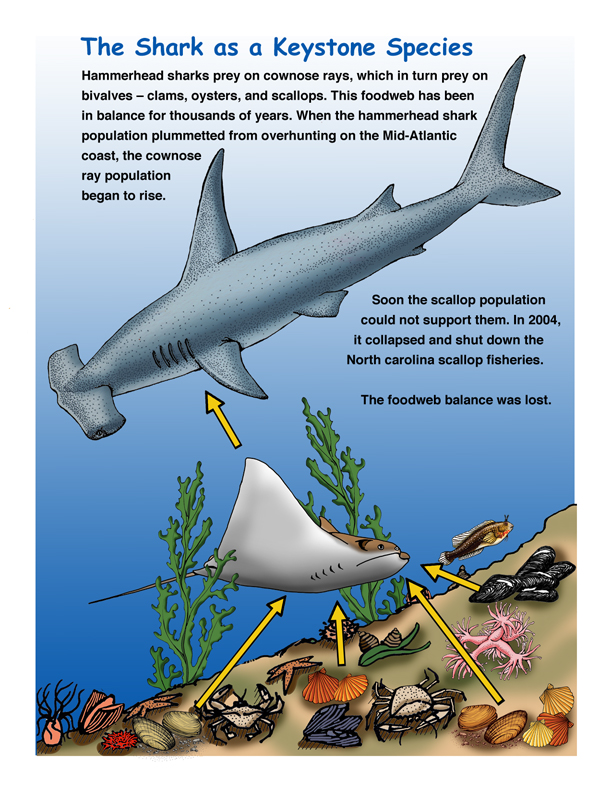

Shark populations have shrunk to less than a quarter of what they once were because of overfishing. Recent evaluations of of fishing practices estimate that more than 100 million sharks are killed every year. This is especially alarming in a species like the shark that grows slowly and does not breed for the first ten years of its life. Even after they begin reproduction, some species, like the thresher shark, only give birth to a half dozen young. This makes recovery from overfishing more difficult.
Much of shark hunting is not for food, but for the development of medical treatments. Shark cartilage and other body parts have been used to treat everything from arthritis to cancer. Unfortunately, there is no scientific evidence to date that any shark products are effective in treating any medical condition.
Sharks play an important role in ocean ecosystems. They are apex predators. This means that they are at the top of their food web and are rarely prey themselves – expect to humans. As predators, they play a role in keeping their prey populations healthy by capturing the slower, weaker fish, turtles, manatee, dolphins, etc. Many are also considered keystone species because of their importance in maintaining a balance in their food webs.
An example of this is the tiger shark. Whether in their habitat on the Great Barrier Reef in Australia or along the coasts of Hawaii, the tiger shark hunts sea turtles. Sea turtles, in turn, eats the seagrass found in shallow coastal waters. Seagrass beds are vital protective habitat for fish and shellfish. If the seagrass beds are overgrazed, the living thing hiding in them becomes visible and more vulnerable to predation. This is what happens when the shark populations decrease. In truth, it is not just sharks eating turtles that keeps the ecosystem in balance. Just the patrolling of sharks in the seagrass beds as they look for prey helps keep the sea turtles moving so they do not overgraze one area.
Sadly, this phenomenon has already been proven in places like Bermuda and along the coastlines of the Indian Ocean, where shark populations have declined and sea turtles populations have risen and entire seagrass beds have disappeared – the fish and shellfish along with them.
Another closer to home example of this is happening along the U.S. Mid-Atlantic coast. Here the decline of sharks has been linked to the rise in the population of cownose rays. This ray preys on bivalves – clams, oysters, and scallops. Their increased demand for food resulted in the collapse of the bay scallop population, which in turn shut down the North Carolina scallop fisheries in 2004. This illustrated just one direct connection between the importance of sharks to humans. This pattern of decreased shark populations, increased ray populations, and decreased scallop fisheries has been seen in other regions like the Northwest Atlantic, Chesapeake Bay and Belize, Central America.
There are many laws in place to protect marine environments.
The Coral Reef Conservation Act (CRCA) was established in 2000 for the purposes of preserving coral reef ecosystems, promoting wise management and gaining better information on the current condition of coral reefs.
The Endangered Species Act was enacted in 1973 to protect animals from extinction. There are three major components of the ESA: listing species as either threatened or endangered, designating habitat that is critical to the species survival and restoring populations of species so they can be removed from the list.
The Magnuson-Stevens Fishery Conservation and Management Act (MSA) governs fish populations within U.S. Exclusive Economic Zone (EEZ) zone (3-200 nautical miles offshore). This act was signed into law in 1976 and there have been reauthorizations of the act several times since then, most recently in 2006.
The Marine Mammal Protection Act (MMPA) was enacted in 1972 in response to growing concerns that certain species and populations of marine mammals were in danger of extinction or depletion as a result of human activities.
The National Marine Sanctuaries Act (NMSA) was enacted in 1972 with the purpose of designating important marine environments as sanctuaries for their environmental, historical or cultural significance. Currently, there are 13 marine sanctuaries in the National Marine Sanctuary System, six of which were created after 1990.
The United Nations Convention on the Law of the Sea (UNCLOS), also called the Law of the Sea Convention or the Law of the Sea treaty, is the international agreement that resulted from the third United Nations Conference on the Law of the Sea (UNCLOS III), which took place between 1973 and 1982.
The Marine Stewardship Council (MSC) is an independent non-profit organization which sets a standard for sustainable fishing. Fisheries that wish to demonstrate they are well managed and sustainable compared to the science-based MSC standard.
Simply, don't buy products made from sharks.
More About Sharks:
Classification of Sharks and Rays (Older Students)
Classification of Sharks and Rays (Younger Students)
Related Activity:
Blue Shark Drawing Lesson
Stingray Drawing Lesson
Shark Word Search
Sharks Hidden Picture and Naming
Related Visual Aid:
Shark at the Aquairum Movie
Related Testing and Assessment:
Sharks Multiple Choice Quiz
Sharks - Name Them
When you research information you must cite the reference. Citing for websites is different from citing from books, magazines and periodicals. The style of citing shown here is from the MLA Style Citations (Modern Language Association).
When citing a WEBSITE the general format is as follows.
Author Last Name, First Name(s). "Title: Subtitle of Part of Web Page, if appropriate." Title: Subtitle: Section of Page if appropriate. Sponsoring/Publishing Agency, If Given. Additional significant descriptive information. Date of Electronic Publication or other Date, such as Last Updated. Day Month Year of access < URL >.
Amsel, Sheri. "Keystone Species - Sharks" Exploring Nature Educational Resource ©2005-2024. December 13, 2024
< http://www.exploringnature.org/db/view/Keystone-Species-Sharks >
